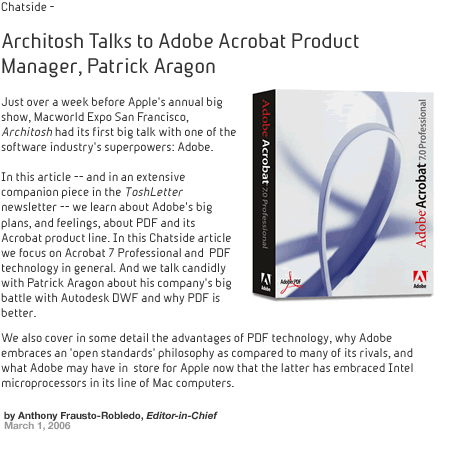|

This
feature article has two key companion pieces published
exclusively inside the new ToshLetter™, which you
can sign-up for and receive here. In fact, issue 4 is
devoted entirely to Adobe PDF technology in AEC, and
the complete Aragon interview is its main feature.
So
if you are very interested in where Adobe is going with
PDF and Acrobat in architecture/engineering/construction
(AEC) in general, then be sure to sign-up
today to get the latest ToshLetter.
Adobe's
Acrobat Story
To
be sure Adobe's PDF technology is everywhere, perhaps
the most prominent standard on the Internet
in terms of a document type beyond HTML. In this Chatside
article we are going to cover a good part of a one-hour
long interview with Patrick Aragon, Adobe's product manager
for the Acrobat family.
We are also publishing a companion piece in our fourth-issue
of the new ToshLetter (PDF-based)
email newsletter.

Today
Adobe is
a company highly focused on document collaboration and
review technologies.
And although the company continues to expand in design
and web applications, recently acquiring its main rival
Macromedia, a central pillar of the company remains Acrobat
and PDF.
Patrick
Aragon, who's background is in engineering, is Adobe's
Acrobat product manager. He told Architosh that
when he joined the
company they were in the middle of the development cycle
for Acrobat 7. "Adobe realized
then that in looking at the very large customer base
there were significant numbers
of AEC users," notes Aragon, "and so they made the decision
to extend support in that direction."
Since
Acrobat 7 Professional was introduced a year ago Patrick
says the take-up in the product has been incredible.
Especially in AEC where the company has been pushing
harder. "The ability to produce PDF files from programs
like Autocad and Microstation has been very popular,"
says Aragon.

From
a manufacturing point-of-view Adobe PDF seems to be literally
everywhere in the market. I asked Patrick what percentage
do they have in AEC. "I can't tell you a precise
number," says Aragon, "Adobe has 1.52 billion copies
of Acrobat Reader in circulation. And that is just what
we are able to count."
Patrick explained that Adobe can't count copies of Acrobat
that come with software packages for example, only those
that are downloaded from Adobe Web servers.
About
'Open Standards'
In
our conversation we talked about the emergence of 3d
in all CAD industries and specifically how Adobe was
dealing with that. I asked Patrick what was on the horizon
-- remember this interview took place a few weeks before
the Acrobat 3d announcement -- besides the .u3d format.
He said, "The .u3d format is an example of our interest
in the CAD markets and that format fits us very well."
In asking him to explain he added: "Because it is
an industry 'open standard' format and that is very much
in-line with our [Adobe's] approach to the market."
Indeed
many in the CAD industry are not fully aware of just
how open Adobe's PDF technology really is. Patrick explained
that every time there is a new release of the technology
(a new version) Adobe publishes the specifications. Additionally,
the company produces Adobe PDF Libraries for third-party
software companies to license. "Bentley is a strategic
partner in this space," explained Aragon. "When we launched
Acrobat 7 they were able to provide the ability to input
.u3d files into PDF documents almost immediately."
continued...>
page:
| 1 | 2 | 3 |
|






![]()
![]()